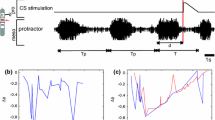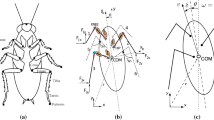Abstract
The coordination of adult stick insects walking on a light double wheel system with a fixed axle is examined as a function of friction loads applied to the wheels. Four parameters are influenced by loads parallel to the body axis in the range 0.08–1.0 p. Protraction duration at low stepping frequency falls to a value equal to that used in high speed walking and is therefore independent of step period for loads >0.4p. Above 0.4p the step period is significantly increased producing coordination patterns similar to those reported for free walking mature adults. Both the anterior (AEP) and posterior (PEP) extreme positions move forward with increasing load for all legs.
Similar content being viewed by others
References
Bässler, U.: Propriozeptoren am Subcoxal und Femur-Tibia-Gelenk der Stabheuschrecke Carausius morosus und ihre Rolle bei der Wahrnehmung der Schwerkraftrichtung (1965)
Bässler, U.: Sensory control of leg movement in the stick insect Carausius morosus. Biol. Cybern. 25, 61–72 (1977)
Bässler, U.: Interaction of central and peripheral mechanisms during walking in first instar stick insects, Extatosoma tiaratum. Physiol. Entomol 4, 193–199 (1979)
Batchelet, E.: Statistical methods for the analysis of problems in animal orientation and certain biological rhythms. A.I.B.S. monograph (1965)
Cruse, H.: On the function of the legs in the free walking stick insect Carausius morosus. J. Comp. Physiol. 112 (1976)
Cruse, H., Saxler, G.: Oscillation of force in the standing legs of a walking insect (Carausius morosus). Biol. Cybern. 36, 159–163 (1980)
Evoy, W.H., Fourtner, C.R.: Nervous control of walking in the crab Cardisoma guanhumi. III. Proprioceptive influences on intra- and intersegmental coordination. J. Comp. Physiol. 83, 303–318 (1973)
Graham, D.: An analysis of walking movements in the first instar and adult stick insect. J. Comp. Physiol. 81, 23–52 (1972)
Graham, D.: Walking kinetics of the stick insect using a low-inertia counter-balanced, pair of independent tread wheels. Biol. Cybern. 40, 49–57 (1981)
Graham, D., Cruse, H.: Coordinated walking of stick insects on a mercury surface. J. Exp. Biol. 92, 229–241 (1981)
Helversen, O.v., Elsner, N.: The stridulatory movements of acrided grasshoppers recorded with an opto-electronic device. J. Comp. Physiol. 122, 53–64 (1977)
Holst, E. von: Über relative Koordination bei Arthropoden. Pflügers Arch. 246, 847–865 (1943)
Macmillan, D.L.: A physiological analysis of walking in the American lobster (Homarus americanus). Philos. Trans. R. Soc. London B 270, P1–59 (1975)
Pearson, K.G.: Central programming and reflex control of walking in the cockroach. J. Exp. Biol. 56, 173–193 (1972)
Spirito, C.P., Mushrush, D.L.: Interlimb coordination during slow walking in the cockroach. I. Effects of substrate alterations. J. Exp. Biol. 78, 233–243 (1979)
Wendler, G.: Laufen und Stehen der Stabheuschrecke Carausius morosus: Sinnesborstenfelder in den Beingelenken als Glieder von Regelkreisen. Z. Vergl. Physiol. 48, 198–250 (1964)
Author information
Authors and Affiliations
Rights and permissions
About this article
Cite this article
Foth, E., Graham, D. Influence of loading parallel to the body axis on the walking coordination of an insect. Biol. Cybern. 47, 17–23 (1983). https://doi.org/10.1007/BF00340065
Received:
Issue Date:
DOI: https://doi.org/10.1007/BF00340065




